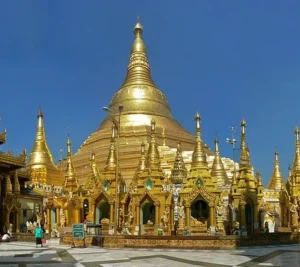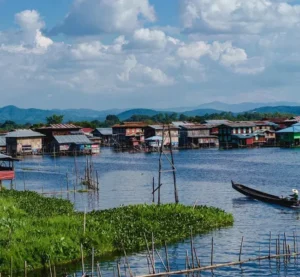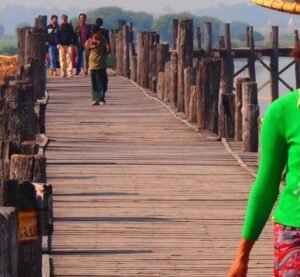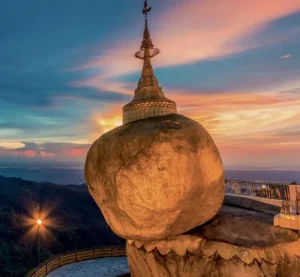Myanmar
UTC+6:30 (Myanmar Standard Time)
One of the few countries with a 30-minute offset
No daylight saving time observed
Myanmar Kyat (MMK)
Symbol: K
US dollars widely accepted in tourist areas
ATMs available in major cities and tourist destinations
January 4, 1948 (from British colonial rule)
Formerly known as Burma until 1989
Home to ancient kingdoms dating back to the 9th century
E-visa available for tourism and business
Visa on arrival at limited entry points
Most nationalities require a visa
ASEAN nationals eligible for visa exemptions
Travel Advisory Note
Due to recent political events and ongoing security concerns in parts of Myanmar, travel conditions may be affected. Always check your country's latest travel advisories and consult local sources before planning your trip. Some areas may have restricted access or heightened security concerns.
Culture
Myanmar's rich cultural tapestry has been woven over thousands of years, influenced by neighboring cultures while maintaining its distinct identity. With 135 officially recognized ethnic groups, the country offers extraordinary cultural diversity, visible in its festivals, crafts, clothing, and traditions.
Key elements of Myanmar culture include:
- Buddhism: Theravada Buddhism is practiced by approximately 90% of the population and profoundly influences daily life, art, architecture, and social norms. Monks in distinctive maroon robes are a common sight, and most males in Myanmar temporarily ordain as monks at some point in their lives, often during adolescence.
- Thanaka: A distinctive yellowish-white cosmetic paste made from ground bark, applied to the face and sometimes arms. It serves as sun protection, skin conditioner, and is considered aesthetically pleasing. This unique cultural practice is most common among women and children.
- Traditional dress: The longyi, a sarong-like garment, is worn by both men and women, though styled differently. Men wear patterned longyis called paso, while women wear htamein with more colorful designs. For formal occasions, men may wear a traditional white jacket (taikpon) over their longyi.
- Arts and crafts: Myanmar has rich traditions in lacquerware, particularly from Bagan; intricate wood carving; gold leaf production used for decorating temples and Buddha images; silk and cotton weaving with distinctive patterns by various ethnic groups; and marionette puppetry (yoke thé).
- Music and dance: Traditional performances often combine singing, orchestral music (hsaing waing), and dance. Instruments include circle of drums (pat waing), bamboo xylophones (pattala), and curved brass gongs (kyi waing). Classical dance draws from ancient court traditions with precise movements and elaborate costumes.
The calendar is punctuated by numerous festivals, many with Buddhist significance. Thingyan (Water Festival) in April marks the Myanmar New Year with joyous water-throwing celebrations. Thadingyut (Festival of Lights) celebrates Buddha's return from heaven with candles and colorful lanterns. Numerous regional and ethnic festivals showcase the country's cultural diversity.
Myanmar's cuisine reflects its geographic position between South and Southeast Asia:
- Mohinga: Often considered the national dish, this savory rice noodle and fish soup is typically eaten for breakfast but available throughout the day from street vendors and restaurants
- Tea leaf salad (lahpet thoke): A unique dish of fermented tea leaves mixed with crunchy beans, peas, peanuts, sesame seeds, and garlic, representing a distinctive flavor not found elsewhere
- Curry dishes: Myanmar curries are typically oil-based rather than water or coconut-based, and traditionally served with a variety of side dishes, fresh and blanched vegetables, and soup
- Shan cuisine: From the northeastern region, featuring distinctive noodle dishes and rice salads with fresh herbs and strong flavors
- Street foods: Samosas, deep-fried tofu, grilled skewers, sweet and savory pancakes, and various rice cakes are available from street vendors throughout urban areas
Tea culture is central to Myanmar social life. Traditional tea shops serve as community gathering places where people socialize, conduct business, and discuss current events. The traditional sweet tea mixed with condensed milk (laphet yay) is served throughout the day, often accompanied by simple snacks.
Tourism & Best Sites to Visit
Myanmar offers travelers a glimpse into a world where ancient traditions remain vibrant parts of everyday life. With thousands of temples, diverse landscapes, and warm hospitality, the country presents unique experiences for those seeking cultural immersion and natural beauty.
Here are some of Myanmar's most remarkable destinations:





Shwedagon Pagoda: The most sacred Buddhist site in Myanmar, this magnificent gold-plated pagoda stands 99 meters tall and is said to contain relics of four previous Buddhas. The main stupa is surrounded by smaller shrines, pavilions, and statues. Particularly magical at sunset when the golden surface glows in the fading light, the pagoda has been a focal point of Burmese spiritual life for over 2,600 years.
Ancient Temples of Bagan: One of Asia's most remarkable archaeological sites, the Bagan Archaeological Zone contains over 2,000 Buddhist temples, pagodas, and monasteries dating from the 9th to 13th centuries, spread across a 26-square-mile plain. Watching sunrise or sunset over this temple-studded landscape, especially from a hot air balloon, offers an unforgettable experience.
Inle Lake: Famous for its unique leg-rowing fishermen and floating gardens, this freshwater lake in the Shan Hills supports a distinctive way of life. Visitors can explore villages built on stilts, witness traditional crafts including silk weaving and silversmithing, and visit the remarkable jumping cat monastery (though the cats no longer jump). The lake's Phaung Daw Oo Pagoda festival features elaborate boat races with dozens of leg-rowers.
U Bein Bridge: Stretching 1.2 kilometers across Taungthaman Lake, this is believed to be the oldest and longest teakwood bridge in the world, built around 1850 using reclaimed wood from a former royal palace. The bridge is particularly photogenic at sunset when silhouettes of monks and locals crossing the bridge create iconic images.
Kyaiktiyo Pagoda (Golden Rock): A small pagoda built on a gold-leaf-covered boulder that appears to defy gravity as it balances on the edge of a cliff. This important pilgrimage site is believed to be held in place by a strand of Buddha's hair. The journey to reach the site, involving a truck ride up winding mountain roads followed by a hike, adds to the mystique of the experience.
Other notable destinations include the former royal capitals around Mandalay; Ngapali Beach with its pristine white sand; Hpa-An's dramatic karst landscape; Mrauk U's mysterious temples; and the colonial architecture of downtown Yangon, including the iconic Strand Hotel.
Transportation
Transportation in Myanmar has improved significantly in recent years, though infrastructure still varies widely between urban and rural areas. The country's geographical diversity, from mountains to river deltas, influences transportation options in different regions.
- Domestic flights: The fastest and most comfortable way to travel between major destinations, especially given the sometimes challenging road conditions. Airlines including Myanmar National Airlines, Air KBZ, and Myanmar Airways International connect major tourist destinations like Yangon, Mandalay, Bagan, Heho (for Inle Lake), and Thandwe (for Ngapali Beach). Flights can be subject to seasonal changes and occasionally experience delays.
- Trains: Myanmar's railway network, dating from the British colonial era, offers a unique if slow travel experience. The Yangon-Mandalay route is the main line, with branches to other destinations. Trains typically offer several classes including ordinary class (basic seating), upper class (reserved seats), and sleeper class on overnight journeys. While not the most efficient option, train travel provides authentic cultural experiences and stunning scenery.
- Buses: An extensive network of buses connects cities and towns throughout the country. Options range from basic local services to "VIP" buses with air conditioning and reclining seats for longer routes. Overnight buses are common for longer journeys such as Yangon to Bagan or Mandalay. Bus travel is generally affordable but can be uncomfortable on rougher roads.
- River transportation: Given Myanmar's major rivers (Ayeyarwady, Chindwin, and Thanlwin), boat travel remains important. Tourist cruises operate on the Ayeyarwady between Mandalay and Bagan, while local ferries provide essential transportation in river delta regions. These range from basic wooden boats to more comfortable vessels with overnight accommodation.
-
Urban transport: In major cities like Yangon and Mandalay:
- Taxis are widely available and relatively inexpensive, though most don't use meters so fares should be negotiated before departure
- Yangon has a circular railway that offers an interesting glimpse into local life
- Trishaws (cycle rickshaws) are common for short distances in many towns
- Motorbike taxis operate in many areas, though tourists riding motorbikes themselves is prohibited in many regions
Transportation tips: Consider these factors when planning travel in Myanmar:
- Book domestic flights in advance during high season (November-February)
- Road quality varies significantly, with journey times often longer than might be expected for the distance
- Train journeys can take twice as long as equivalent bus trips due to the aging railway system
- Private car hire with a driver is a comfortable option for exploring specific regions, though more expensive than public transportation
- English signage can be limited outside major tourist areas, so having destinations written in Burmese can be helpful
Note on access: Some areas of Myanmar have travel restrictions for tourists, particularly in border regions. These restrictions can change, so it's advisable to check current regulations before planning trips to more remote areas.
Airports
Myanmar has three international airports and numerous domestic airports connecting major tourist destinations and regional centers:
- Yangon International Airport (RGN): The main gateway to Myanmar and busiest airport in the country, located about 15 km from downtown Yangon. The modern international terminal handles flights from major Asian cities including Bangkok, Singapore, Kuala Lumpur, and cities in China, as well as some Middle Eastern connections. Most international visitors enter Myanmar through this airport.
- Mandalay International Airport (MDL): Located about 35 km south of Mandalay city, this is Myanmar's second-largest airport. It handles both international flights from regional hubs and domestic connections. The airport was built in the 1990s with significant capacity for future growth and features modern facilities.
- Naypyidaw International Airport (NYT): Serving the capital city, this airport was opened in 2011 and has capacity for large aircraft. Despite its modern facilities, it handles relatively few flights compared to Yangon and Mandalay airports, with limited international connections.
-
Key domestic airports: Several smaller airports serve important tourist destinations:
- Nyaung U Airport (NYU) for access to Bagan
- Heho Airport (HEH) serving Inle Lake and the Shan State
- Thandwe Airport (SNW) for Ngapali Beach
- Sittwe Airport (AKY) for access to Mrauk U
Airport Transportation: Options for reaching your destination from major airports include:
- Yangon Airport: Taxis are the most convenient option, with a fixed-rate system to various parts of the city. The journey to downtown typically takes 45-60 minutes depending on traffic. Some hotels offer airport pickup services, which should be arranged in advance.
- Mandalay Airport: Located quite far from the city, taxi services are available with fixed rates. The journey takes about 60 minutes. Shared taxi services may also be available at lower rates.
- Regional airports: Taxis and sometimes shared vans are available, though prices and availability vary. At Nyaung U Airport (Bagan), horse carts can sometimes be found alongside more conventional transportation.
Important notes: International flights to Myanmar can have restricted schedules, sometimes operating only on certain days of the week. Many travelers reach Myanmar via regional hubs like Bangkok or Singapore. When departing, it's recommended to arrive at the airport well in advance (3 hours for international flights, 1.5 hours for domestic) as processing can sometimes be slow. Airport facilities outside of Yangon and Mandalay may be basic, with limited food options or amenities.
Visa & Travel Information
Most foreign visitors require a visa to enter Myanmar, though the process has been simplified in recent years with the introduction of e-visas and visa-on-arrival options for many nationalities.
Visa Types and Requirements
The following table outlines visa options for different nationalities:
| Nationality | Visa Options | Duration |
|---|---|---|
| Most Western & Asian Countries | E-Visa Available | Tourist: 28 days, Business: 70 days |
| ASEAN Nations (Brunei, Cambodia, Indonesia, Laos, Philippines, Thailand, Vietnam) | Visa-Free Entry | 14 days |
| Singapore, Japan | Visa-Free Entry | 30 days |
| Select Countries | Visa on Arrival | Varies by visa type |
| Other Nationalities | Embassy Visa Required | Varies by visa type |
E-Visa Process: Myanmar's official e-visa website (evisa.moip.gov.mm) allows eligible travelers to apply online. The process typically involves:
- Completing an online application form with personal and travel details
- Uploading a recent digital photo
- Paying the fee (approximately $50 USD for tourist visa, $70 for business visa)
- Processing typically takes 3 business days (standard) or 24 hours (express service)
- Approved e-visas are sent via email and must be printed to present upon arrival
Entry points: E-visas are only valid for entry through designated international entry points including Yangon, Mandalay, and Naypyidaw international airports, and certain land border crossings with Thailand. Travelers planning to enter via other points must obtain a traditional visa from a Myanmar embassy or consulate.
Important Travel Considerations
- Political situation: Myanmar has experienced significant political changes in recent years. Some areas may have travel restrictions or security concerns. It's advisable to check your country's travel advisories before planning your trip.
- Health precautions: No mandatory vaccinations are required for entry, though travelers are advised to be up-to-date on routine vaccinations. Malaria prophylaxis is recommended for some rural areas, particularly during the rainy season. Tap water is not potable, and food hygiene varies.
- Money: Myanmar remains largely a cash economy, though credit cards are increasingly accepted at higher-end hotels and restaurants in major tourist areas. ATMs are available in cities and tourist destinations, though service can be intermittent. US dollars are widely accepted for larger expenses, but must be in pristine condition (no tears, marks, or folds).
- Internet and communications: Wi-Fi is available in most hotels and many restaurants in tourist areas, though connection speeds can be slow. Mobile data coverage has improved significantly, with tourist SIM cards available at airports and major cities.
Best time to visit: Myanmar has three distinct seasons:
- Cool season (November-February): Generally considered the best time to visit, with moderate temperatures and minimal rainfall. This is peak tourist season, especially in December and January.
- Hot season (March-May): Temperatures can reach 40°C (104°F) in central areas like Bagan and Mandalay. While this means fewer tourists, the heat can be challenging for sightseeing.
- Rainy season (June-October): Monsoon brings regular rainfall, particularly to coastal and southern regions. Some areas have limited access, and boat services may be reduced. However, the landscapes are lush, and major sites have fewer visitors.
Cultural etiquette: Myanmar people are generally conservative and deeply respectful of Buddhist traditions. When visiting religious sites, shoulders and knees should be covered, and shoes and socks must be removed. It's inappropriate to touch anyone on the head or point feet toward people or Buddha images. Public displays of affection should be avoided. Permission should be asked before photographing individuals, particularly monks and nuns.